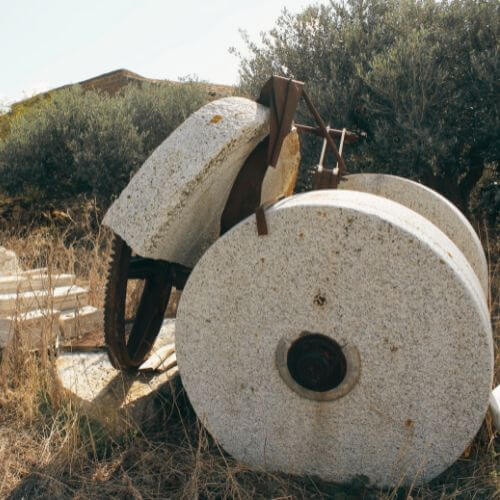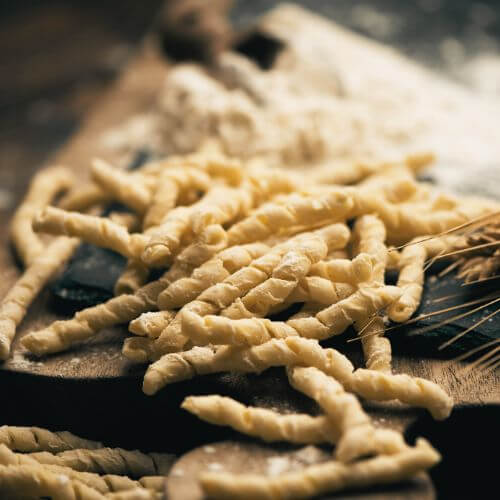Choose from our Ancient Grain Whole Wheat Pasta Collection





Gluten, But Not As You Know It
The Sicilian Ancient Grain Secret to Digestibility
Ancient Grains, cherished for their natural lower gluten content, boast an untouched gluten molecule—far from the modified "frankengluten" found in modern GMO varieties.
At Papa Vince, we pride ourselves on preserving the original gluten structure, which is inherently weaker and more digestible than its contemporary counterparts.
This fundamental difference makes our pasta not only supportive of anti-inflammatory diets but also ensures it's gentle on your digestive system, leaving you free from the discomfort of bloating.
This leads us to the following question: Is gluten different in Italy than in the United States? The answer is YES.
Why? The processes involved in wheat production and pasta making in Italy are more respectful of the wheat, resulting in a different gluten composition.
Italy emphasizes traditional methods without the extensive enrichment, sulfites, emulsifiers, bleaching, and unnatural additives commonly found in American wheat products. These processes in the U.S. can lead to issues beyond gluten itself, affecting gluten quality and potentially causing problems for individuals who are not celiac but sensitive to these additives.
Therefore, the distinct approach to wheat processing in Italy contributes to a gluten composition that is perceived to be more tolerable and beneficial for many individuals, even those without celiac disease.
Enjoy Pasta Again!
EAT GOOD.
Embrace the Wholsomeness of Low Gluten Ancient Grain Pasta
Our Low Gluten Ancient Grain Pasta is crafted from Sicilian ancient grains, offering a digestible and nutritious alternative to regular pasta. These grains contain 40-60 times less gluten than standard American wheat, ensuring a gentler experience for your digestive system.
Thanks to our traditional cold-stone grinding process, we preserve the whole food matrix and the grains' complete nutritional profile, including bran, germ, and endosperm. This method maintains the original, weaker gluten structure, making our pasta significantly easier to digest.
LOW GLUTEN
ARTISANAL PASTA
_____________
FEEL GOOD.
Feeling light as a cloud after pasta? Believe it!
Rich in natural fibers and unrefined carbs from the original bran, germ, and endosperm: our pasta promises a meal free from the bloating, sluggishness, or sugar spikes that often accompany refined flour dishes.
Enjoy pasta again with Papa Vince's uniqueness, where each serving is a gentle embrace to your digestive system, ensuring you feel light as a cloud. It's not just pasta; it's a return to how food should make you feel—nourished, satisfied, and wonderfully light.
NUTRITIOUS, SATISFYING PASTA THAT'S GENTLE AND REVITALIZING
_____________
THRIVE RAW.
Reviving Tradition for
Digestive Health: Pasta that's
Gentle on Your Gut
Crafted for easy digestion, our pasta supports nutrient absorption, boosting your energy without the usual post-meal sluggishness. Say goodbye to the fear of feeling bloated and enjoy each meal with confidence.
Experience the vitality that comes from nourishing pasta that's kind on your gut, energizing your body naturally. Thrive Raw, energized, and free from digestive woes.
SAY GOODBYE TO BLOATING
_____________
SEE WHAT OUR CUSTOMERS ARE SAYING
ANCIENT WHOLE WHEAT: NUTRIENT-RICH POWER

ANCIENT GRAINS
- Ancient Grains contain 40-60 times less gluten than Modern Intensely Hybridized Grains.
- Ancient Grains have a superior nutritional profile compared to modern, mass-produced wheat varieties.
- Ancient Grains have higher levels of vitamins, minerals, and proteins, all in their natural form. No fortification needed.
- Ancient Grains are high in antioxidants & phytonutrients, which are not as prevalent in modern wheat.
- Ancient Grains remain unchanged for centuries.
- Ancient Grains grown strong & tall in harsher climates & poorer soils with no herbicides, no pesticides, no insecticides.

COLD-STONE GRINDING
- Cold-stone grinding preserves the whole food matrix, keeping the whole grain intact and ensuring the gluten remains naturally digestible.
- Cold-stone grinding preserves all the parts of the wheat: bran, endosperm & wheat germ.
- Cold-stone grinding preserves the wheat's heat sensitive nutritional properties, including its natural proteins, omega-3 fatty acids, and fiber content.
- Cold-stone grinding preserves the wheat's original structure and the nutritional synergy of its components
- Papa Vince offers a superior whole wheat pasta made from original components instead of synthetic vitamins, synthetic fibers, synthetic proteins, and synthetic nutrients.

SLOW DRYING
- Unlike industrial high-heat drying, our Slow drying process prevents the original gluten structure from being damaged by heat, keeping it more digestible.
- Slow drying allows moisture to evaporate gently, preserving the pasta's natural starch content and structure.
- Slow drying preserves the pasta's heat-sensitive nutrients, including vital vitamins (specifically B Vitamins) and antioxidants.
- Papa Vince Ancient Grain Pasta offers a nutritionally superior profile compared to its high-temperature, rapidly dried counterpart, which lacks nutrients.
FAQ - Why Italian Pasta Is a Gluten-Sensitive Paradise
Does Italian pasta have less gluten than American Pasta?
Italian pasta typically contains less gluten than American pasta due to the types of wheat used and the cultivation methods. In Italy, traditional pasta is often made from ancient wheat varieties (like durum wheat, tumminia wheat, and einkorn), which have a different gluten structure compared to modern wheat (like hard red wheat).
Ancient grains contain 40-60 times less gluten than Modern Grains. They also contain the original gluten structure, which is much weaker than the gluten found in modern grains, making it much easier to digest and even supporting anti-inflammatory diets.
Additionally, Italian milling processes often produce flour that retains more of the original grain's nutrients and fiber, contributing to its unique nutritional profile. These factors, along with the use of traditional processing methods like cold-stone grinding, bronze-die cutting, and slow drying, can result in Italian pasta being recognized as easier to digest for some individuals and potentially containing less gluten than American pasta.
Is there less gluten in whole wheat pasta?
Whole wheat pasta is made using the entire wheat kernel, which includes the bran, germ, and endosperm. This integral use of the grain results in pasta that's denser in nutrients, including fiber, vitamins, and minerals, because the bran and germ are rich in these elements.
Refined pasta, on the other hand, is made by removing the germ and bran, focusing solely on the starchy endosperm. This process strips away a significant portion of the grain's nutritional content, yielding a product with a softer texture and a lighter color but fewer health benefits.
However, while whole wheat pasta is richer in nutrients and fiber than refined pasta, it still contains gluten.
Papa Vince’s Pasta is made from ancient grains containing 40-60 times less gluten than Modern Grains. These grains also contain the original gluten structure, which is much weaker than the gluten found in modern grains. This makes the pasta much easier to digest and even supports anti-inflammatory diets.
Can gluten-sensitive people eat pasta in Italy?
Yes, gluten-sensitive individuals can enjoy pasta in Italy, thanks to the country's widespread recognition and accommodation of gluten sensitivity and celiac disease.
Italy is renowned for its culinary inclusivity, offering a broad array of gluten-free options that cater to those with gluten-related disorders. Italian law requires gluten-free food options in schools, hospitals, and public places, and many restaurants across Italy are well-versed in handling gluten-free diets, often providing delicious gluten-free pasta dishes made from alternative grains such as rice, corn, buckwheat, or quinoa.
Moreover, the Italian Celiac Association (AIC) works diligently to increase awareness and improve the availability of gluten-free options. They also certify restaurants that meet strict gluten-free handling standards, making it easier for gluten-sensitive travelers to find safe dining options.
The attention to detail and care in preparation ensures that those who need to avoid gluten can still indulge in Italy's rich pasta culture without concern.
Is pasta in Italy healthier?
The perception that pasta in Italy is healthier than in America stems from the focus on high-quality ingredients, traditional cooking methods, portion control, and cultural practices that prioritize simplicity and balance in Italian cuisine.
Ingredients:
Traditional Italian pasta is typically made from durum wheat semolina and water without additives commonly found in some American brands. This focus on high-quality, minimalistic ingredients contributes to the overall health profile of Italian pasta.
In contrast, some American pasta brands may contain additives and refined flours that reduce the nutritional content of the pasta.
Cooking Methods:
Italians often follow traditional pasta-making methods and prefer homemade cooking. Pasta in Italy is often cooked "al dente," which means it is cooked just enough to retain a firm texture. Overcooked pasta can affect blood sugar levels due to a higher gastric rate, emphasizing the importance of healthier cooking methods.
American pasta dishes may sometimes include larger portions and heavy, rich sauces, leading to higher calorie and fat intake compared to the more moderate and balanced approach in Italian cuisine.
Portion Control:
Italian pasta consumption emphasizes portion control. Italians enjoy their meals slowly and in moderation. This practice contrasts with the American habit of larger servings, which can lead to overeating and potential health issues.
Nutritional Profile:
Italian pasta is often considered healthy due to its nutritional profile and specific culinary traditions. It is made from high-quality ingredients and balanced cooking methods, contributing to its reputation as a healthier option.
While American pasta's nutritional content can vary based on brands and ingredients, the perception that Italian pasta is healthier is often linked to the emphasis on simplicity, quality, and moderation in Italian cuisine.
Why is Italy so gluten-free friendly?
Italy is known for being accommodating to individuals with celiac disease or gluten intolerance due to several factors that contribute to a gluten-free friendly environment. Here are the key reasons based on provided sources:
Cultural Awareness: Italy has a strong cultural awareness of celiac disease and gluten intolerance. Italian children are routinely screened for celiac disease in schools, and there is widespread understanding of the condition and its dietary requirements among the general population.
Supportive Infrastructure: The Italian Celiac Society (AIC) plays a significant role in promoting gluten-free options and ensuring that restaurants and food establishments meet strict standards for gluten-free preparation. This organization certifies restaurants that adhere to stringent processes to prevent cross-contamination and provide safe gluten-free meals.
Dedicated Gluten-Free Establishments: Italy boasts numerous dedicated gluten-free bakeries, restaurants, and shops scattered across the country. These establishments cater specifically to individuals with celiac disease or gluten intolerance, offering a wide range of safe and delicious gluten-free options.
Labeling Laws: Italy has stringent food labeling laws that require explicit identification of gluten-free products. This makes it easier for individuals with gluten sensitivities to identify safe food options and confidently navigate the culinary landscape.
Traditional Culinary Practices: Traditional Italian baking practices, such as long fermentation processes like those used in making ancient grains sourdough bread, can influence the gluten structure, potentially making it easier to digest for some individuals with gluten sensitivities. These methods contribute to the overall gluten-free friendly environment in Italy.
In summary, Italy's cultural awareness, supportive infrastructure, dedicated gluten-free establishments, labeling laws, and traditional culinary practices all contribute to making Italy a gluten-free friendly destination where individuals with celiac disease or gluten intolerance can confidently enjoy authentic Italian cuisine without compromising their dietary needs.
FAQ - Why Ancient Grains Should Be Your Gut's New Best Friend
Can Ancient Grains Be a Healthier Option for Gluten Sensitivities?
Absolutely, ancient grains represent a healthier choice for individuals with gluten sensitivities due to their unique gluten structure, which is different from modern wheat. Because of ancient grain’s inherent biodiversity, this particularly distinguishes the genetic spectrum compared to modern wheat, that has been hybridized for very few gluten gene diversity.
This difference results in a less elastic and potentially less inflammatory response, making ancient grains particularly beneficial for those with gluten sensitivities or anyone interested in anti-inflammatory dietary choices.
The distinct gluten composition in ancient grains, such as spelt, farro, and einkorn, may be easier to digest for some people, reducing the risk of discomfort or adverse reactions commonly associated with gluten consumption.
Moreover, these grains offer a wealth of nutritional benefits, including high levels of fiber, protein, vitamins, and minerals, contributing to a well-rounded diet. Their diverse nutritional profile can support overall health, offering an array of antioxidants and phytonutrients that promote digestive health, improve metabolic functions, and may even reduce the risk of chronic diseases.
For those navigating gluten sensitivities, integrating ancient grains into their diet can open up new avenues for enjoying a variety of foods without compromising on taste or nutritional value.
Why Is the Gluten in Ancient Grains Considered Less Inflammatory?
Ancient grains possess a gluten structure inherently different from that of modern wheat, making it less elastic and potentially less inflammatory. This characteristic is especially beneficial for individuals with gluten sensitivities or those pursuing anti-inflammatory dietary choices.
Ancient grains' less elastic gluten suggests a healthier option, aligning with the needs of those looking to maintain a balanced and sensitive diet.
Can Switching to Ancient Grain Pasta Ease Gastrointestinal Issues?
Incorporating ancient and heritage grains into one's diet could improve health. Clinical trials have demonstrated that these grains can diminish inflammation, bolster metabolic health, and even assist individuals with specific gastrointestinal issues.
The shift towards ancient grains is more than a dietary trend; it's a return to the roots of nutrition and wellness. Papa Vince’s Ancient Grain Pasta stands as a testament to the timeless virtues of ancient grains, inviting you to experience enhanced nutrition, richer taste, and a profound connection to age-old culinary practices with every bite.
Why is low-temperature slow dried pasta easier to digest?
Our meticulous low-temperature slow drying process is designed to maintain the natural structure of gluten within the pasta, making it significantly easier to digest. This thoughtful preservation means that our pasta not only offers a higher nutrient content but also a more agreeable experience for your digestive system compared to mass-produced options. With Papa Vince's pasta, you enjoy both the rich flavors of Sicily and a meal that's kind to your body.
FAQ - The Revival of Artisanal Italian Pasta
What's the difference between Italian and American Non-Enriched Wheat?
The difference between Italian and American non-enriched wheat largely hinges on cultivation practices and regulations regarding GMOs and pesticide use, notably glyphosate (herbicide).
Italian wheat, especially non-enriched varieties, is typically grown under stringent European regulations that favor non-GMO crops and significantly restrict the use of glyphosate and other chemicals. This approach ensures that the wheat remains as natural and untouched as possible, preserving its nutritional integrity and flavor.
In contrast, even when non-enriched, American wheat may still be produced from GMO strains and is more likely to be exposed to glyphosate and other pesticides during cultivation. These practices can raise concerns about potential health impacts and environmental sustainability. The use of glyphosate, in particular, has been a point of contention, with debates over its safety and effects on human health and the ecosystem.
Choosing Italian non-enriched wheat means opting for a product that aligns with stricter standards for GMOs and pesticide use, offering a cleaner, potentially safer ingredient for consumers who prioritize natural and environmentally friendly agricultural methods.
Why Choose Pasta Made with Ancient Grain Wheat Semolina?
Indulge in a slice of Italy with our Sicilian Ancient Grain Wheat Semolina Pasta, a nod to the timeless traditions of Italian cuisine. Celebrating the full, untouched essence of the wheat grain, our pasta is made from durum wheat semolina, known for its golden hue and rich, nutty flavor.
This choice reflects our commitment to preserving the grain's wholesome goodness and natural aroma, offering an authentic taste of Sicilian heritage in every bite.
How Do We Keep Antioxidants and Fiber Intact in Every Bite?
Our secret to preserving the wheat's soul lies in the age-old art of cold stone grinding. This traditional method keeps the natural proteins, omega-3s, antioxidants from the germ, and fiber from the bran intact, unlike modern processing techniques that can diminish these essential nutrients.
Papa Vince’s Pasta boasts an unparalleled 'al dente' texture and a perfect balance of robust, earthy tones and a subtle sweetness—thanks to our dedication to preserving these vital nutrients.
Why are Ancient Grains from Sicily the Best?
In countries like Canada, France, and the USA, the battle against fungus and mycotoxins is a significant concern for wheat cultivation, often compromising the integrity of the whole wheat berry, forcing them to use fungicides.
Did you know certain people mistake gluten sensitivity with being allergic or sensitive to fungicides?
However, Sicily stands apart in this regard, thanks to its dry and hot climate that naturally discourages fungus growth. This favorable environment allows for the preservation of the entire whole wheat berry without the worry of mycotoxin contamination.
The unique climatic conditions of Sicily provide an ideal setting for growing wheat that is both healthy and pure, ensuring that the risk of fungus-induced damage is minimized and the quality of the wheat remains uncompromised.
At Papa Vince, we Lab Test all our products to ensure no mycotoxin contamination and no fungicides are used during farming.
Why can Ancient Grains from Sicily be Cultivated without Pesticides?
Sicilian ancient grains, celebrated for their extraordinary biodiversity and resilience, flourish without the need for fertilizers, pesticides, or artificial irrigation.
Genetically akin to einkorn wheat, humanity's oldest known wheat, these grains provide a gluten-sensitive option, yielding a nutritious and digestible whole wheat berry.
Science is now uncovering the potential of these resilient grains, which have flourished under the influence of diverse cultures throughout history.
FAQ - Artisanal Traditional Pasta Making Process
Stone-Ground vs. Refined: What Difference Does It Make in Our Pasta?
Far from the stripped-down essence of refined flours, our durum wheat semolina is a testament to whole grains' integrity. By choosing not to refine our semolina, we ensure that the pasta retains the complexity of flavors and nutrients that refined counterparts often lose.
This commitment to maintaining the semolina’s natural state allows us to deliver a product that tastes better and aligns with our vision of offering healthful, nourishing food.
Why Our Pasta Grabs Sauce Better? The Bronze-Die Cut Secret
The traditional method of bronze-die-cut pasta involves extruding pasta dough through bronze dies, resulting in a rough, porous texture on the noodles. This rough texture allows sauces to adhere effectively to the pasta, enhancing the overall flavor and dining experience.
On the other hand, modern non-stick die-cut pasta, often made using Teflon-coated dies for quicker and more cost-effective pasta production, produces pasta with a smooth, almost satiny surface. While the smooth surface may look visually appealing, it does not provide the same level of sauce absorption and texture as bronze-die-cut pasta.
The rough texture of bronze-die-cut pasta allows sauces to cling better to the noodles, creating a harmonious marriage between the pasta and sauce.
Slow vs. Fast-Dried Pasta: What’s the Difference and Why it Matters?
The differences between slow, low-temperature drying pasta and rapid, high-temperature drying pasta are substantial. These differences affect the pasta's texture, flavor, nutritional value, and interaction with sauces and cooking processes.
Texture:
• Rapidly dried pasta, processed at high temperatures, often ends up denser, with a yellower appearance and a more slippery texture due to tighter protein networks and protein degradation. This alteration makes the pasta less porous and not as adept at absorbing sauces.
• In contrast, slow-dried pasta retains a tenacious, elastic texture that is neither too sticky nor too slick. This ensures even cooking and achieves the ideal 'al dente' consistency cherished in pasta dishes.
Nutritional Value:
• The rapid drying process, with its high temperatures, can diminish the pasta's nutritional content and make it harder to digest.
• On the other hand, slow drying at lower temperatures safeguards the pasta’s nutritional integrity. It protects heat-sensitive components such as B vitamins and antioxidants/polyphenols, resulting in a product that's richer in flavor and lighter on the stomach, ensuring a more balanced and digestible meal.
Cooking Properties:
• Quickly dried pasta can exhibit a rubbery texture and may not integrate as well with sauces, often bouncing rather than blending in the palate. This is partly due to the starch not fully gelatinizing into a smooth paste.
• Conversely, pasta that is slow-dried dissolves more readily into a creamy consistency when cooked and combined with sauces, enhancing the overall culinary experience with a lush texture that perfectly complements its condiments.
In essence, while rapid drying can compromise pasta quality across various aspects, slow drying meticulously preserves the pasta's inherent qualities. This method ensures a superior texture, richer nutritional profile, and a more enjoyable eating experience, solidifying slow-dried pasta's position as the preferred choice for those seeking the authentic essence of pasta cuisine.
Can Switching to Ancient Grains Improve Your Dietary Habits?
Unlike modern wheat, which has been selectively bred for higher gluten strength and yield, ancient grains offer a gluten quality that is inherently less inflammatory and more digestible.
This makes them a superior choice for those looking to improve their dietary habits. Modern grain hybridization and gene alteration have primarily affected wheat's protein content, resulting in ancient grains having a weaker gluten index in their more naturally occurring form.
Additionally, the protein content is why ancient grain pasta, made in the traditional way, preserves superfood levels of nutrition in terms of vitamins and minerals.
What Nutritional Edge Do Ancient Grains Hold Over Modern Ones?
Ancient grains hold a significant nutritional edge over modern ones.
They are not just about lower gluten toxicity; they are nutritional powerhouses enriched with antioxidants, vitamins, minerals, and micronutrients.
Research underscores the benefits of ancient grains for their digestible gluten and reduced levels of immunogenic proteins, which contribute to decreased inflammation and improved tolerance for gluten-related disorders.
Furthermore, the elevated presence of secondary metabolites and polyphenols in ancient grains enhances their metabolic and clinical benefits, underscoring their nutritional superiority.
Why Are Natural Proteins and Omega-3s More Potent in Our Pasta?
Our pasta's standout nutritional profile, featuring highly potent natural proteins and omega-3s, stems from our commitment to the age-old technique of cold stone grinding.
This artisanal process is the cornerstone of our approach, ensuring the wheat's vital nutrients—natural proteins, omega-3 fatty acids, antioxidants, and fiber—are preserved in their most wholesome form.
Unlike modern processing methods, which often strip away these essential nutrients, our traditional grinding technique safeguards the wheat's nutritional integrity.
This meticulous process preserves our pasta's dense nutritional content and imbues it with an unparalleled 'al dente' texture and a harmonious blend of robust, earthy flavors complemented by a hint of subtle sweetness.
At Papa Vince, we believe in honoring the wheat's soul by retaining its healthful essence, offering you a pasta experience that is not only delicious but deeply nourishing.

OUR FAMILY COMMITMENT
All our Pastas follow the same quality guidelines
Papa Vince Pasta
Non-GMO Ancient Grains
Heirloom Cultivation
Low Gluten content
Weak Gluten, easier to digest
No Glyphosate used in farming practice
No Bleaching
Non-Enriched
Non-Fortified
Cold-Stone Grounded
No Pesticides
No Herbicides
No Insecticides
No Irrigation - Conserves Water
No Synthetic Fibers
No Synthetic Vitamins
Generic Pastas
Modern Grains
Intensive Hybridization
High Gluten content
Strong Gluten, more difficult to digest
With Glyphosate used in farming practice
Bleached
Enriched
Fortified
High-Temperature Steel Milled
With Pesticides
With Herbicides
With Insecticides
With Irrigation
With Synthetic Fibers
With Synthetic Vitamins
All the A’s to your Q’s about Our Low Gluten Artisanal Pasta
What is gluten?
Gluten is a composite of storage proteins termed gliadins and glutenins, found in wheat and related grains, including barley and rye. It serves as a sort of dietary "glue" that imparts elasticity to dough, helping it to rise and maintain its shape, and often gives the final product a chewy texture. This unique property of gluten is particularly appreciated in the culinary world, as it lends desirable characteristics to a wide variety of foods, from bread and pasta to cakes and other baked goods.
In pasta, gluten plays an indispensable role. It is the gluten in the wheat that allows pasta to have its remarkable texture, enabling it to not only maintain its form but also to hold onto sauces more effectively. This interaction between gluten and pasta's texture enhances the dining experience, making the pasta not just a carrier for sauces but a delightful element of the dish that contributes to its overall taste and mouthfeel.
However, it's important to understand the distinction between gluten found in modern, industrially processed wheat products and that in ancient grains. Over the years, due to the demands of industrial food processing, modern wheat has undergone intense hybridization. This selective breeding was aimed at enhancing specific traits, notably to produce a stronger form of gluten that benefits commercial baking and food manufacturing. The gluten in these contemporary wheat varieties is structurally more robust, which is key for producing the high-volume, airy breads and durable pasta desired in commercial products.
The vast majority of biodiversity found in wheat has been significantly reduced in modern varieties due to intensive inbreeding, a stark contrast to the rich genetic variety present in ancient wheat like einkorn, emmer, and spelt. These ancient grains possess natural, biodiverse gluten, which is inherently weaker, leading to products that may not match the industrial robustness of modern, highly hybridized wheat but offer a gluten that is more digestible. This natural biodiverse gluten reflects not just in its ease of digestion but also in the resilience and health of the wheat plants themselves, which thrive without the need for pesticides, fertilizers, or fungicides. Lacking in the biodiversity of numerous genes that confer robustness and adaptability, modern wheat stands in contrast to its ancient counterparts. Natural biodiverse gluten, with its less complex and weaker structure, highlights the advantages of ancient grains for individuals with sensitivities to modern wheat, underlining the intrinsic link between plant genetic diversity, health, and the nutritional quality of the food we consume.
The differences in gluten strength, biodiversity, and digestibility between ancient and modern wheat varieties underscore the significance of understanding gluten's role not just in culinary applications but also in health and nutrition. As consumers become more interested in the origins and impacts of the foods they consume, the choice between ancient grains and modern wheat varieties becomes an important consideration, especially for those concerned with digestive health and food sensitivities.
What is Gluten Intolerance?
Gluten intolerance refers to a range of adverse reactions that some people experience after consuming gluten, a protein found in wheat, barley, rye, and other grains.
There are two main types of Gluten Intolerance:
• Celiac Disease: This is an autoimmune disorder where the body's immune system attacks and damages the small intestine when gluten is consumed. Even tiny amounts of gluten can cause severe intestinal damage and malabsorption of nutrients in those with celiac disease. It is a serious condition that requires strict, lifelong adherence to a gluten-free diet.
• Non-celiac gluten sensitivity (NCGS): This is a condition in which people experience symptoms similar to those of celiac disease after consuming gluten, but without the same intestinal damage or autoimmune response. The exact causes of NCGS are not well understood, but it is believed to involve issues like intestinal permeability and immune activation.
Symptoms of gluten intolerance can include:
• Abdominal pain, bloating, diarrhea, constipation
• Fatigue, headaches, brain fog
• Joint pain, numbness
• Skin rashes
• Anemia and nutritional deficiencies (in celiac disease)
The only treatment for gluten intolerance is adhering to a strict gluten-free diet by avoiding wheat, barley, rye, and cross-contamination. For those with celiac, even tiny amounts can be harmful. NCGS may allow the consumption of very low gluten levels for some people.
What is Celiac Disease?
Celiac disease is a chronic digestive and immune disorder triggered by consuming gluten, a protein found in wheat, barley, rye, and other grains.
When individuals with celiac disease ingest gluten, their immune system mounts a response that damages the small intestine's lining, leading to malabsorption of nutrients and causing various symptoms such as diarrhea, fatigue, weight loss, bloating, anemia, and more.
This autoimmune condition affects the body's ability to absorb essential nutrients, potentially resulting in serious health complications if left untreated.
Celiac disease affects about 1% of the population worldwide. Strict dietary adherence is crucial to prevent long-term complications like osteoporosis, infertility, and intestinal cancers.
What is Gluten Sensitivity?
Gluten sensitivity, also known as non-celiac gluten sensitivity (NCGS) or gluten intolerance, refers to a condition where individuals experience symptoms after consuming gluten-containing foods, similar to those with celiac disease but without the same antibodies and intestinal damage seen in celiac disease.
People with gluten sensitivity may have gastrointestinal symptoms like bloating, gas, and fatigue, as well as extraintestinal symptoms such as headaches, brain fog, joint pain, and numbness in the extremities.
Many individuals with Non-Celiac Gluten Sensitivity (NCGS) may actually be reacting not to the gluten itself but to artificial additives prevalent in many commercially processed foods. Common culprits include dough conditioners, bleaching agents, and fungicides—substances not found in our artisan pasta.
Unlike mass-produced options in the USA, our artisanal italian pasta is crafted with a commitment to purity and tradition. We eschew artificial additives in favor of natural, wholesome ingredients. This approach ensures that our pasta retains its nutritional integrity and offers a more digestible alternative for those sensitive to the unnecessary chemicals often found in conventional pasta products.
Is gluten intolerance the same as celiac disease?
Gluten intolerance and celiac disease are not the same conditions. While both are triggered by an inappropriate immune system response to gluten, a protein found in wheat, rye, and barley, they differ in their symptoms and severity.
• Celiac disease is an autoimmune disorder that causes damage to the small intestine when gluten is consumed, leading to serious medical complications and requiring a strict gluten-free diet for management.
• On the other hand, gluten intolerance, also known as non-celiac gluten sensitivity, does not involve immune system damage to the intestine and does not lead to the same severe medical issues as celiac disease.
Individuals with gluten intolerance may experience uncomfortable gastrointestinal symptoms after consuming gluten but do not suffer from the intestinal damage characteristic of celiac disease.
Can I eat Gluten-Free in Italy?
Yes, you can eat gluten-free in Italy, and the country takes this matter seriously, especially for individuals with celiac disease.
In Italy, when a restaurant is designated as gluten-free, it often means that the establishment goes above and beyond the typical precautions. Many of these restaurants have two separate kitchens to avoid cross-contamination—one dedicated entirely to preparing gluten-free dishes. This rigorous approach ensures that individuals with celiac disease can dine with confidence, knowing that their meals are prepared in an environment that minimizes the risk of exposure to gluten.
Eating gluten-free in Italy is widely understood as a health necessity for those diagnosed with celiac disease, rather than a dietary preference. The country's widespread recognition of celiac disease and its efforts to accommodate those affected by it are exemplary. Italian restaurants that offer gluten-free options are well-versed in the strict dietary restrictions required for managing celiac disease and are committed to providing safe, delicious meals to all patrons, regardless of their dietary needs.
This commitment to inclusivity and safety in dining makes Italy a welcoming destination for those who need to follow a strict gluten-free diet, ensuring they can enjoy the rich culinary landscape of Italy just like everyone else.
Is this pasta gluten-free?
While our pasta is made from ancient grains with gluten, similar to what Ancient Romans consumed, it is not gluten-free. However, it's often found to be easier to digest and less likely to cause bloating.
Can this pasta fit into an anti-inflammatory diet?
Yes, our pasta is a good source of fiber and proteins, supporting anti-inflammatory diets by providing nutrient-rich, clean food that's lab-tested to be free from artificial additives, preservatives, or pesticides.
How does your pasta help avoid after-meal lethargy?
The natural fibers and proteins in our pasta mitigate sugar rushes, helping to prevent the common after-meal lethargy associated with refined carbohydrates. This is because stone grinding the whole wheat berry preserving the bran, germ, and endosperm preserves the entire of the food matrix, which is more slowly digested.
Is Whole Wheat Pasta less processed?
In the US, whole wheat pasta is not necessarily less processed due to the common practice of adding back nutrients that were stripped away during the processing phase.
Often, what is marketed as "whole wheat" pasta might better be described as "reconstructed whole wheat." This means that the germ and bran, integral components of the wheat grain that are removed during initial processing, are later reintroduced as isolated ingredients.
This process differs significantly from traditional, artisanal methods, where the whole grain—with all its parts intact—is preserved throughout the entire production, ensuring a less processed final product.
This traditional, artisanal approach not only maintains the nutritional integrity of the pasta but also aligns more closely with what consumers might expect from a product labeled as “whole wheat”.
Why is pasta healthier in Italy than in America?
Pasta is often considered healthier in Italy than in America due to differences in ingredients and processing.
Authentic Italian pasta is made using whole grains and avoids enrichment or fortification, which helps to retain the natural nutrients of the wheat. Papa Vince's pasta is an example of going back to artisanal, traditional methods. Moreover, employing traditional Italian pasta-making techniques, such as slow drying at low temperatures, helps preserve the nutritional value and flavor of the pasta.
In the United States, there's a pronounced lean towards Big Food's modern, industrial methods in pasta production. American pasta is often crafted from refined flour, subjected to high-temperature drying in industrial settings, and commonly enriched with vitamins and minerals. This approach significantly alters the pasta's natural nutritional profile, distancing it from the traditional, artisanal practices that prioritize the preservation of inherent nutrients.
So, to determine the nutritional quality of pasta, regardless of its origin, it's essential to check the ingredient list for keywords like "enriched flour" or "enriched semolina" and look for products that maintain the grain's natural nutrient profile.
How can you tell pasta is high quality?
Judging the quality of pasta can be tricky, but there are a few key pointers you can use:
Appearance:
• Color: High-quality durum wheat pasta will have a slightly off-white or light yellow color, not an intense yellow. An intense yellow color often indicates the use of lower-quality wheat or added coloring.
• Texture: The pasta should look smooth but not overly polished. A slightly rough texture suggests the bran wasn't completely removed, indicating whole wheat or high-quality semolina.
• Shape: Look for consistent shapes without breaks, cracks, or deformities.
Ingredients:
• First Ingredient: The first ingredient listed should be "durum wheat semolina" or "whole wheat durum semolina." Avoid pasta with refined wheat flour as the first ingredient.
• Enrichment: This depends on your preference. Non-enriched pasta retains its natural nutrient profile, while enriched pasta has added vitamins and minerals.
• Additives: Avoid pasta with unnecessary additives like artificial colors, flavors, or preservatives.
Cooking & Texture:
• Cooking time: High-quality pasta usually cooks slightly longer than lower-quality varieties due to its denser texture.
• Texture after cooking: The pasta should be firm to the bite ("al dente"), not mushy or sticky. It should hold its shape well and not release excessive starch into the cooking water.
• Taste: High-quality pasta should have a slightly nutty or sweet flavor characteristic of durum wheat. It shouldn't taste bland or powdery.
What's the best way to cook your pasta for a perfect 'al dente'?
To achieve the perfect ‘al dente’ texture with our pasta, follow these steps:
1. Bring water to a rolling boil.
2. Once boiling, add sea salt. It's important to wait until the water is boiling; adding salt earlier can affect the boiling point and timing.
3. Add the pasta to the boiling water.
4. As the water returns to a boil, begin checking the pasta for your preferred texture. For that ideal 'al dente' quality, aim for a balance between softness and a slight crunch.
5. Taste the pasta and adjust the salt to your liking.
6. Once it reaches your desired 'al dente' texture, briefly introduce cool water to the pot. This stops the cooking process immediately, ensuring your pasta doesn't overcook.
7. Drain the pasta and serve it with your sauce of choice or use it as the base for a delightful pasta salad.
What differentiates your pasta from other brands?
Our pasta is crafted from ancient durum whole wheat, cold stone ground, and processed using traditional Sicilian methods, ensuring a nutrient-rich, non-GMO product without bleaching or enrichment.

Over 50,000+ Happy Customers






























